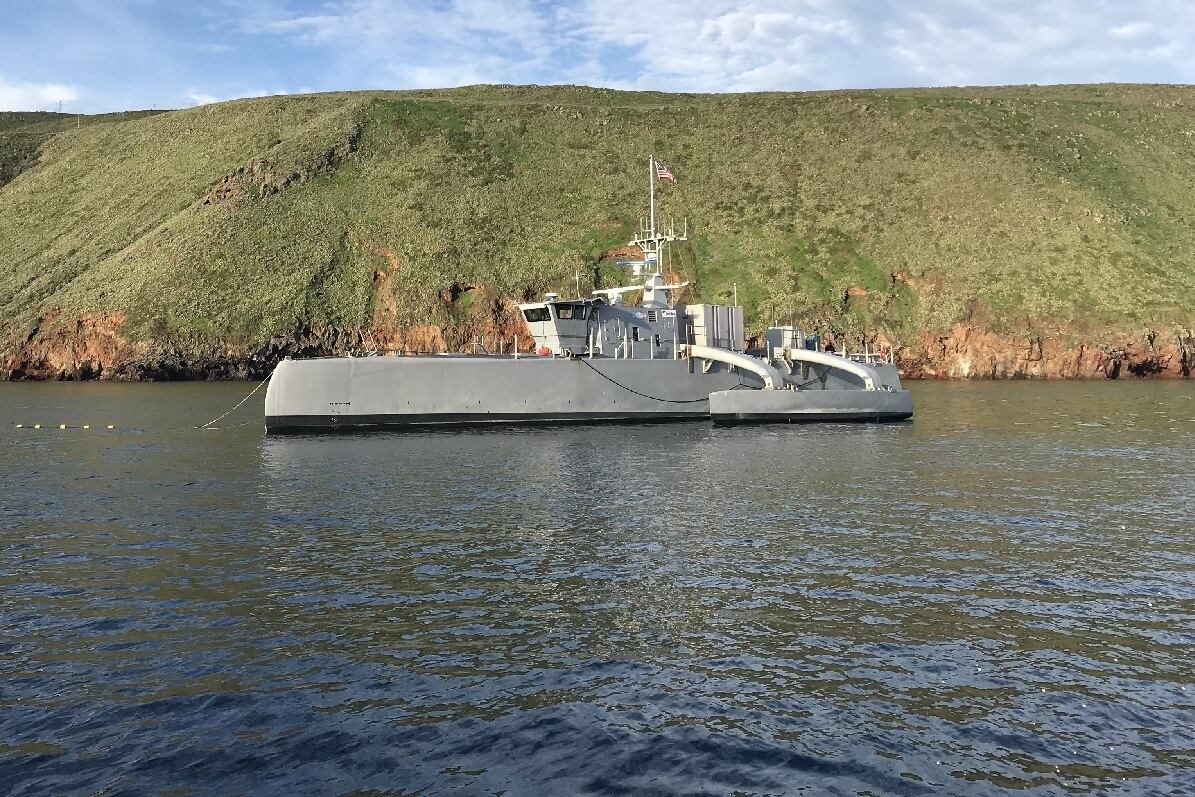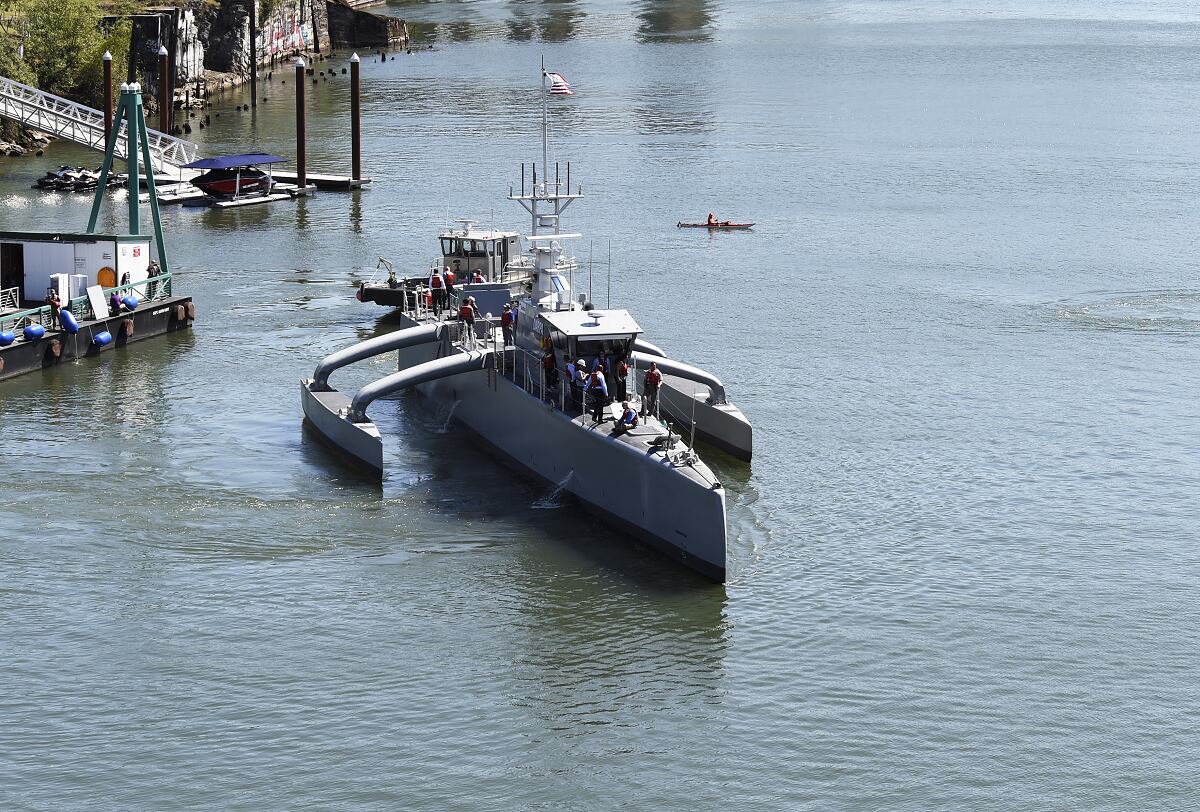WASHINGTON — The U.S. Navy’s plans for unleashing robot warships on the world’s oceans may need some work, according to a new study.
The way the Navy describes its planned large unmanned surface vessel, or LUSV, is as an external missile magazine that can significantly boost the number of missile tubes fielded for significantly less money than buying Arleigh Burke-class destroyers, which cost nearly $2 billion per hull.
The problem? China is pumping out warships like it’s going out of style: A recent photo of a Chinese shipyard taken by an airline passenger showed nine destroyers under construction and an aircraft carrier. In 2018, China surpassed the U.S. Navy as the world’s largest naval force.
That has led the U.S. Navy to aggressively push toward an LUSV equipped with a vertical launching system, or VLS, to get the punch of a missile-shooting frigate for less money.
RELATED

“We can’t continue to wrap $2 billion ships around 96 missile tubes in the numbers we need to fight in a distributed way against a potential adversary that is producing capability and platforms at a very high rate of speed,” the U.S. Navy’s top officer, Adm. Michael Gilday, said in recent comments.
The Navy has discussed equipping the LUSV with the ability to house sailors, but the vessel would be largely designed as an unmanned platform, which would save money because of there likely won’t be a need for structure that supports human habitation. Sailors supporting an LUSV might use a port-a-potty and eat MREs rather than building an at-sea septic system and galley, for example.
But therein lies the problem with the LUSV, according to a new study from the Center for Strategic and Budgetary Assessments: What do you do with those vessels, that the Navy intends to buy in numbers, when you’re not trading missiles with China?
Before the Navy gets too far down the road of fielding an optionally manned LUSV, the Navy should just pony up for a more expensive but more useful corvette that, in the event of war, could be unmanned and used as the envisioned external missile magazine, the study said.
“The Navy’s planned LUSV would also be an approximately 2,000-ton ship based on an [offshore support vessel] design,” the study read. “In contrast to the optionally manned LUSV, the DDC [corvette] would be an optionally unmanned vessel that would normally operate with a crew. By having small crews, DDCs could contribute to peacetime training, engagement, maritime security, and deterrence.”
In other words, for every scenario short of war, there would be a small warship that can execute normal naval missions — missions that ideally deter conflict from occurring in the first place.
RELATED

The corvette would maintain a small crew but would still be able to operate autonomously if need be, the report explained.
“Instead of procuring an optionally manned LUSV that may be difficult to employ throughout the spectrum of competition and conflict, CSBA’s plan introduces a similarly designed DDC that is designed to be, conversely, optionally unmanned and would normally operate with small crews of around 15–24 personnel,” the report read. “DDCs primarily armed with offensive weapons would serve as offboard magazines for force packages.”
This is different from the idea put forward by Navy officials over the past year. In June, at a conference of the American Society of Naval Engineers, the head of Program Executive Office Unmanned and Small Combatants told the audience his vision is to keep the ship as autonomous as possible, de-emphasizing the crew’s role.
“From my perspective, the optional manning that might be on one of these USVs is not there to operate the vessel,” Capt. Pete Small said. “The vessel itself is autonomous. You don’t need people there to drive the ship, the people are there potentially for the employment and safekeeping of the payloads.
“So we’re keeping a narrow view on what optional manning is with respect to our USVs.”

The difference, it appears, is philosophical: The Navy is developing an “optionally manned” ship; CSBA and lead author Bryan Clark are proposing an “optionally unmanned” ship.
It may seem like a small difference, but building a ship designed from the ground up to support humans is a major difference from a boat that can accommodate a few humans if the operators want to.
The good news is that no matter what the Navy decides, it has some time. The first two LUSVs, for which Congress appropriated funds in the 2020 budget, are part of the service’s effort to build prototypes for experimentation and integration of maritime technologies.
The service will not, however, be allowed to integrate vertical launching system cells as planned.
Is there misalignment?
The CSBA study didn’t just take issue with the direction of the large unmanned surface vessel, but also with the composition of the whole surface fleet.
The study found that the destroyer-heavy surface fleet is completely misaligned for both its peacetime and wartime missions, and things that were once strengths have become vulnerabilities.
Destroyers packing heavy-duty air defense radars will betray their position to high-end adversaries, like China and Russia, who employ advanced electronic detection equipment. Furthermore, weighting the fleet toward large surface combatants means the Navy is focusing too much on manning and maintaining their assets to perform peacetime missions, which often don’t require all the capabilities of a destroyer.
Instead, the Navy should lean on the proposed corvettes and medium unmanned surface vessels — something akin to the Sea Hunter drone developed by the Defense Advanced Research Projects Agency — to reduce the risk of adversaries detecting the large manned combatants.
“New concepts for surface fleet missions ... will increasingly rely on unmanned systems to perform sensing operations because unmanned systems can achieve the proximity or distribution to use passive sensors effectively or employ active sensors at acceptable risk,” the study read.
The study called for a fleet of 74 large surface combatants by 2048, down from the current 104 requirement, and keeps the 52 small surface combatant requirement of the 2016 Force Structure Assessment.
The study also said the Navy requires a total of 96 corvettes and 110 medium unmanned surface vessels.
Inverting the fleet from a destroyer-heavy, manpower-intensive fleet to a smaller, more adaptable force, bolstered by cheaper ships and more offensive punch, would ultimately increase the number of vertical launching system cells available to the fleet by 1.4 times the current projected number, the study found.
David B. Larter was the naval warfare reporter for Defense News.







